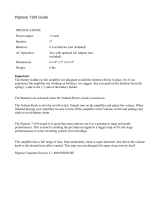
20 En
Specifications
POWER SECTION
• Minimum RMS Output Power
(8 Ω , 20 Hz to 20 kHz, 0.02% THD) ...................... 90 W + 90 W
(6 Ω , 20 Hz to 20 kHz, 0.02% THD) .................. 105 W + 105 W
(4 Ω , 20 Hz to 20 kHz, 0.02% THD) .................. 140 W + 140 W
• Dynamic Power (IHF) (8/6/4/2 Ω) ................... 105/135/190/220 W
• Maximum Output Power
(1 kHz, 0.7% THD, 4 Ω) [U.K. and Europe models only]
.......................................................................................... 160 W
• Maximum Useful Output Power (JEITA)
(1 kHz, 10% THD, 8/4 Ω)
[Asia, General, China and Korea models only] ....... 115/190 W
• Dynamic Headroom
8 Ω ..................................................................................... 0.67 dB
• IEC Output Power [U.K. and Europe models only]
(1 kHz, 0.02% THD, 8/4 Ω)............................................ 90/145 W
• Damping Factor
1 kHz, 8 Ω ................................................................................ 160
• Maximum Input Signal
CD, etc. ................................................................................. 2.8 V
PHONO MM (1 kHz) ........................................................ 120 mV
PHONO MC (1 kHz) ............................................................ 7 mV
• Frequency Response
CD, etc. (Flat Position, 5 Hz to 100 kHz) ...................... +0/−3 dB
CD, etc. (Flat Position, 20 Hz to 20 kHz) ................... +0/−0.3 dB
• RIAA Equalization Deviation
PHONO MM (20 Hz to 20 kHz) ...................................... ±0.5 dB
PHONO MC (20 Hz to 20 kHz) ....................................... ±0.5 dB
• Total Harmonic Distortion
CD, etc. to SP OUT
(20 Hz to 20 kHz, 90 W/8 Ω) ........................................... 0.015%
PHONO MM to REC
(20 Hz to 20 kHz, 2 V) ..................................................... 0.005%
PHONO MC to REC
(20 Hz to 20 kHz, 2 V) ....................................................... 0.05%
• Intermodulation Distortion
CD, etc. to SP OUT
(Rated output, 8 Ω) ............................................................0.02%
• Signal to Noise Ratio (IHF-A Network)
CD, etc. (150 mV, Input shorted) ..........................................98 dB
PHONO MM (5 mV, Input shorted) .....................................93 dB
PHONO MC (500 µV, Input shorted) ..................................85 dB
• Residual Noise (IHF-A Network) .......................................... 73 µV
CONTROL SECTION
• Input Sensitivity/Input Impedance
CD, etc. .................................................................. 150 mV/47 kΩ
MM ......................................................................... 2.5 mV/47 kΩ
MC ........................................................................... 100 µV/50 Ω
MAIN IN ...................................................................... 1 V/47 kΩ
• Output Level/Output Impedance
REC OUT ............................................................. 150 mV/1.5 kΩ
PRE OUT ..................................................................... 1 V/1.5 kΩ
• Headphone Rated Output
1 kHz, 32 Ω , 0.2% THD ................................................... 23 mW
• Channel Separation
CD, etc. (5.1 kΩ Terminated, 1 kHz/10 kHz) ................. 74/54 dB
PHONO MM (Input shorted, 1 kHz/10 kHz, Vol.:−30 dB)
....................................................................................... 90/77 dB
PHONO MC (Input shorted, 1 kHz/10 kHz, Vol.:−30 dB)
....................................................................................... 66/65 dB
• Tone Control Characteristics
BASS
Boost/Cut (50 Hz) ............................................................. ±9 dB
Turnover Frequency ........................................................ 350 Hz
TREBLE
Boost/Cut (20 kHz) ........................................................... ±9 dB
Turnover Frequency ....................................................... 3.5 kHz
• Audio muting......................................................... –20 dB (approx.)
GENERAL
• Power Supply
[U.S.A. and Canada models] ............................. AC 120 V, 60 Hz
[Asia model] .................................. AC 220/230–240 V, 50/60 Hz
[General model] ............... AC 110/120/220/230–240 V, 50/60 Hz
[China model] .................................................... AC 220 V, 50 Hz
[Korea model] .................................................... AC 220 V, 60 Hz
[Australia model] ............................................... AC 240 V, 50 Hz
[U.K. and Europe models] ................................. AC 230 V, 50 Hz
• Power consumption ................................................................ 350 W
• Idling power consumption......................................................... 80 W
• Off-state power consumption ......................................................0 W
• Dimensions (W x H x D) ................................. 435 x 137 x 465 mm
(17-1/8” x 5-3/8” x 18-5/16”)
• Weight ............................................................... 22 kg (48 lbs. 8 oz.)
* Specifications are subject to change without notice.




















